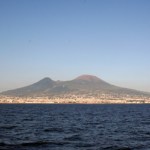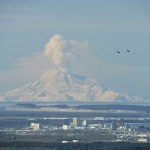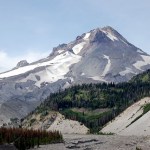mitigation
Sorry about the lack of posts - the holiday and "real life" had stepped in the way.
On with the news!
Mayon Volcano in the Philippines with Legazpi City in the foreground.
Mayon, one of the most active volcanoes in the Philippines, is causing concern due to increasing signs of activity. Renato Solidum, the director of PHIVOLCS (Philippine Institute of Volcanology and Seismology), said that there has been increasing seismic activity and "glow" at the summit of the volcano near (~20 miles / 45 km) Legazpi City. However, even after this sense of increasing activity, the alert level (1) has not…
Your weekly dose of volcano news brought you by the Smithsonian Institute GVP and the USGS.
This week's highlights (not counting Sarychev Peak and Turrialba) include:
13,000 foot / 4 km ash plumes from Rinjani in Indonesia. This is part of the continuing eruption there.
The alert level was lowered at Galeras, Colombia to "Orange" after intense eruptions last week.
The current lava dome at Redoubt is 1 km long, 460 m wide, and 200 m high according to the latest images from the Alaskan volcano.
18,000-23,000 foot / 4.8-7.7 km ash plumes from Shiveluch in Kamchatka, along with thermal anomalies…
Sarychev Peak in Russia erupting on June 14, 2009. Image courtesy of the NASA Earth Observatory.
The transpacific air routes over the Aleutians, the Kamchatka Peninsula and the Kuril Islands are a prime location for the threat of ash to commercial aviation. Many of these volcanoes, especially on the western side of the Pacific Ocean are not closely monitoring and sometimes only remote sensing techniques can keep track of the activity.
Case in point is the current eruption at Sarychev Peak in the Kuril Islands. The volcano is on one of the southern-most Kuril Islands (Ostrov Matua) in Russia…
The latest in my Volcano Profiles Series, we turn to Europe and Vesuvius. You could fill many, many volumes with the works produced on Vesuvius since Roman times. This profile will barely scratch the surface when it comes to the vast geologic and human history surrounding the volcano, but it is a start. If you want to learn more about the archaeology surrounding Vesuvius, try visiting Blogging Pompeii.
VOLCANO PROFILE: MT. VESUVIUS
Mt. Vesuvius in Italy. Image courtesy of Dario Leone.
Location: Italy
Height: 1,281 m / 4,203 ft
Geophysical location: The tectonics in the Mediterranean are…
Karangetang in Indonesia erupting during the mid 1990s. Image courtesy of VolcanoWorld.
The alert level at Karangetang, one of the most active volcanoes in Indonesia, was raised to Orange over the weekend and people living near the volcano have been evacuated. The volcano is apparently already producing ash and lava flows, but it is mostly the ash hazard that is prompting the evacuations. Karangetang erupts almost every year and sometimes with deadly consequences, as in 1992 when 6 settlers near the volcano perished.
You'll have to excuse the curtness of this post. An bad hop in softball will do that to you.
Here's some news:
Mt. Dempo in Indonesia
Xinhua offers some nice pictures of the current activity going on at the summit crater at Nyiragongo in the Congo. Note the partially-crusted-over lava lake in the first shot. The Red Cross is updating the evacuation and mitigation plans for the area as the volcano shows increased activity.
The alert level at Mt. Dempo in Indonesia was raised to the second highest level. There has been ash fall (as far as 10 km from the vent) and volcanic gas emissions. The…
El Misti in Peru, as seen from Arequipa.
As I like to remind people concerning volcanic hazards, an ounce of prevention is worth a pound of the cure. This is not to imply we can prevent volcanic hazards from affecting us, but rather that proper mitigation in the form of monitoring, planning, education and practice can save countless lives (and dollars) when a volcano erupts. Officials in Peru seem to believe this, as they recently ran for practice evacuations for residents around El Misti, in the southern part of the country. Jersy Mariño from the Instituto Geológico, Minero y…
Manam in Papua New Guinea erupting in 2004
Five years ago, Manam volcano in Papua New Guinea erupted. The volcano is located on a 10-km island of the same name and when it erupted in 2004, it produced pyroclastic flows and lava flows to the tune of a VEI 4 eruption. It was decided that the 9,000 inhabitants of the island had to be evacuated but even so, five people died due to the eruption. However, there are still thousands of people in temporary care centers on the main island of Papua New Guinea. Tensions have flared with the local inhabitants, to the point that four former islanders have…
Anak Krakatau in Indonesia.
Eruptive activity is definitely on the uptick at Anak Krakatau. The Jakarta Globe is reporting that the volcano is "spewing molten lava 1000 meters in the air". I'm not entirely sure if that is accurate or that the volcano is throwing volcanic bombs or tephra that high. The head of the Volcanology and Geological Disaster Mitigation Center in Indonesia, merely referred to as Surono in the article (are we playing Brazilian soccer?), says that the volcano is "a high threat because the eruptions have started spreading." Again, I'm not too sure what that means, whether…
All the eruptions fit to print from the Smithsonsian/USGS GVP Weekly Report.
A few highlights (not including Redoubt, Rinjani and Slamet):
Multiple ash plumes from Galeras (Colombia), some producing noticeable ash fall up to 35 km from the vent.
The Alert Level at Anak Krakatau, Indonesia was raised to 3 (out of 4) after a sharp increase in the number of explosions.
The Alert Level at Cleveland in Alaska was lowered from Yellow to "Unassigned" (no Green for Cleveland as there is no real-time seismic network for the volcano, thus no "background levels" to compare.)
Ebeko in Russia continues…
Chaiten erupting in May 2008. Image courtesy of ONEMI.
Speaking of anniversaries, this weekend is the one-year mark for the Chaiten eruption (in spanish) in Chile, the first eruption at the volcano in ~9,000 years. Yes, indeed, the rhyolite eruption that caught most everyone by surprise is still going strong one year later, with two domes growing within the caldera (in spanish). The eruption produced some of the most impressive and sustained ash columns in years (see below) - climbing to 16 km/9 mi, abundant lahars and pyroclastic flows from the emergence and growth/collapse of the domes and…
Mt. Barujari erupting in 1994. Image courtesy of Vulkaner.no.
Sometimes it is hard to appreciate how many volcanoes lie within Indonesia. However, within the last few weeks, no less than four Indonesian volcanoes have been put on alert to eruption or shown increased signs of activity - Slamet, Kirinci, Anak Krakatau and now Mt. Rinjani (above).
UPDATE 5/3/2009 11AM (Pacific): The volcano is erupting according to the Jakarta Globe. Seems like the activity so far is confined to small explosions emitting ash and gases. More info as I find it.
Rinjani is a popular tourist destination on the…
It`s kind of nice to hear an expert in the field making the same observation I often have about the economic arguments that swirl around the climate policy debates.
Specifically, opponents to mitigation policy have no trouble relying on the magic of the market and technology to rescue us from any possible difficulty climate change might visit upon us. This of course includes the loss of huge services nature provides us for free. You know, things like rain and sea food and forests.
Yet, make a suggestion that CO2 emissions need to be forced lower and the Pollyanna`s instantly become the most…
Redoubt in April 2009 with Anchorage in the foreground (along with two F-22 Raptors). Image courtesy of Calvin Hall.
It has been quite some time since I talked about Redoubt, mostly because the volcano has been in the "slow extrusion of a dome" mode that has not generated much beyond impressive steam (with some ash) plumes. The volcano continues to stay at Orange/Watch status. I did glean a few interesting facts and speculations about the future at Redoubt from Dr. Jake Lowenstern of the USGS the other day, including:
The new dome growing on the volcano has more room to expand than the 1989…
Volcano monitoring. Image courtesy of the USGS.
Last night I had the opportunity to see a talk given by YVO Scientist-in-Charge Dr. Jake Lowenstern as part of the Volcanological Society of Sacramento meeting and he gave a great talk on the state of volcano monitoring today in the U.S. He laid out a lot of details concerning the Volcano Hazards Program of the USGS and I thought I'd share some of them so we can all have an idea of the ups and downs of the VHP these days.
First off, nothing says fun like the U.S. Volcano Status Map! Apparently the dreaded watch "eye" was not meant to be a…
Back in the days when Eruptions was on Wordpress, I held a vote about what volcano should be the next to be profiled on this blog. The winner was Mt. Hood in Oregon, and after much waiting, the profile is here. I will actually be out of town until Monday doing some house shopping in this little town. Enjoy this look at one of the most picturesque (and hazardous - #4 in fact) volcanoes in the lower 48 states.
VOLCANO PROFILE: MT. HOOD
Mt. Hood, Oregon in August 2008 taken by Erik Klemetti.
Location: Oregon, U.S.A.
Height: 3,426 m / 11,240 ft
Geophysical location: Along the Cascade arc where…
Well, after lamenting the slow volcano news, things are beginning to pick up again. Beyond the news of a potential increase in activity at Anak Krakatau, there are a few other newsworthy bits that have come up:
Mt. Kerinci in Indonesia
Mt. Kerinci in Indonesia is showing signs of eruption. The volcano is the highest mountain on the island of Sumatra, reaching 3,800 m / 12,400 feet and last erupted in March 2008. Its volcanic activity is marked by small (VEI 2) explosions of ash and tephra. Currently, the volcano is experiencing increased tremors and minor explosions that rained ash on a tea…
Anak Krakatau erupting in 2007.
There is a report out tonight that activity might be increasing at Anak Krakatau in Indonesia, however, it is unclear whether it is actually increasing or not. People are evacuating the coastal area of the Sunda Strait to Bandarlampung in fear that a major eruption of the volcano is on the horizon. However, the Volcanology and Geological Disaster Mitigation Center (PVMBG) in Indonesia has not changed the alert status at Anak Krakatau and it remains at 2 of 4 (~Orange Status). The volcano has been erupting almost constantly for the last few years, producing…
It has been rather quiet on the volcano-front in the last week. Redoubt and Llaima (in spanish), after a few weeks of intense eruption, are both back on Orange Alert. News of the eruptions from Hunga Tonga Hunga Ha'apai and Fernandina is rather sparse in the details. The news of volcanism in 2009 seems to have settled down.
A few tidbits I caught over the weekend:
Chaiten
Damage wrought by the eruption of Chaiten on the town of Chaiten in Chile, taken in early December 2008. Image courtesy of the NASA Earth Observatory.
Don't you feel like you're read this sort of story before after other…
Active US volcanoes and volcano observatories
After all the well-publicized words of "a certain governor in the lower forty-eight" (as Sen. Begich (D-AK) likes to call him) the "wasteful" spending on volcano monitoring improvements in the U.S. have become reality. Sec. of the Interior Ken Salazar announced $15.2 million dollars to modern the infrastructure of the nation's volcano monitoring networks (that is out of the ~$3 billion that went to the Interior - making volcano monitoring a whopping 0.5% of the stimulus that went to that department). Much of this money will likely go to one of…


